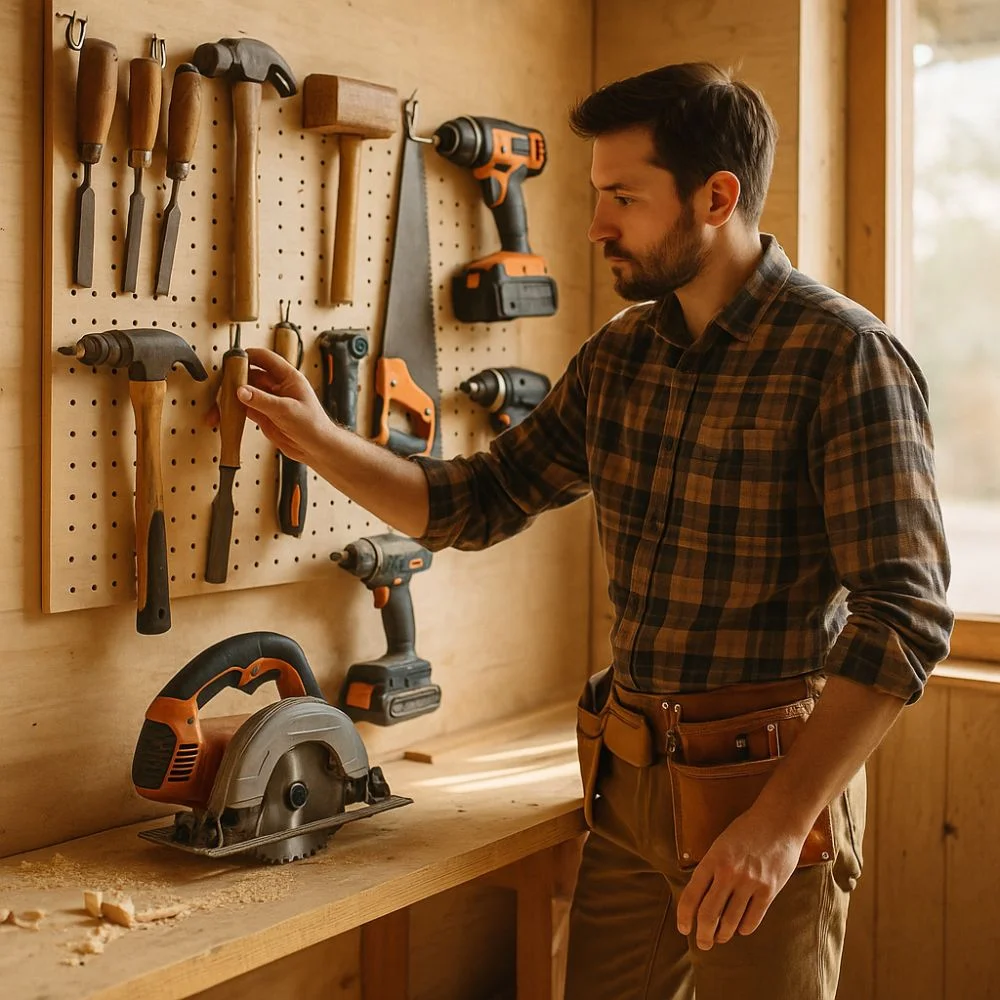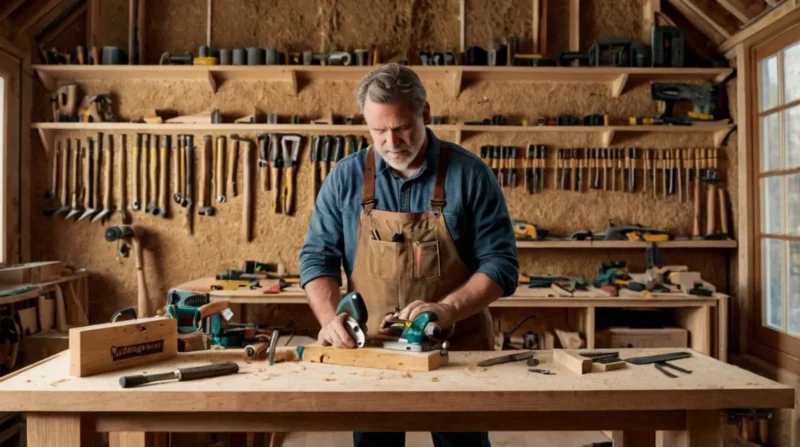Table of Contents
Ever wondered what a carpenter with tools does each day? Let’s Discuss.
Early Morning Routine
The day begins early, around 5:30 or 6 AM, with a quick breakfast and strong coffee. A carpenter knows that a good start sets the tone. They lay out their carpenter tools: tape measure, hammer, chisels, saws, and levels. Checking that each tool is clean and working is key; no one wants a broken tool in the middle of a project.
Next, they review the day’s plan. Whether it’s framing a wall or building cabinets, blueprints are essential. This morning session ensures nothing is forgotten.
Heading to the Job Site
With tools packed, the carpenter drives to the job site. On arrival, they unload everything neatly and organize their workspace. Safety gear, hard hat, goggles, gloves, and ear protection, is checked and worn before any real work begins.
Measuring & Cutting Wood
Once tools are ready, it’s time to measure lumber precisely. A tape measure, a square, a level, and a pencil are used to mark cut lines. Then come the cutting handsaws, circular saws, or jigsaws to handle this stage. Precision here matters: “Measure twice, cut once” is a golden rule. Doing this carefully saves time and materials and keeps clients happy.
Crafting & Assembly
After cutting, the carpenter starts fitting and joining. Using chisels, hammers, screwdrivers, and drills, they assemble frames, cabinets, or other structures. Each joint is checked for fit and alignment; cosmetic or functional adjustments may follow. Working alongside electricians or plumbers ensures everything fits well and follows the project’s design.
Midday Break
Around noon, it’s time for lunch and a break. Carpenters may chat with co-workers, relax, or plan the afternoon work. This rest helps keep energy up for a long day ahead.
Installation & Finishing
Post-lunch is for detailed work. Installing doors, trim, molding, or cabinets involves sanding, staining, and sealing. The finishing stage gives the project its professional look.
Hand tools like planes, rasps, and sandpaper, combined with power tools, bring everything together beautifully.
Problem-Solving on the Spot
Unexpected things happen: uneven walls, warped lumber, and last-minute plan changes. A skilled carpenter adapts and solves these issues quickly. This flexibility builds trust and keeps the job on track.
Cleanup & Tool Care
As the day ends, usually between 4:30 and 6 PM, the carpenter cleans up. Sawdust is swept away, scrap wood is removed, and tools are cleaned and stored. A tidy site is safer and ready for the next day.
Review & Tomorrow’s Plan
Back at home or in the truck, the carpenter reflects on achievements. What went well? What needs follow-up? Reviewing today means tomorrow starts clearly, with supplies restocked and tools charged.
Why This Matters to You?
- Transparency: You understand what happens each day on the job.
- Trust: A well-structured workflow means better results.
- Value: Skilled carpenters are efficient, precise, and adaptable.
Tools of the Trade
| Tool | Purpose |
|---|---|
| Tape Measure, Square | Accurate measuring and marking |
| Handsaw/Power Saw | Cutting wood to size |
| Hammer & Nails | Joining and fastening |
| Drill & Screws | Installations and securing |
| Chisels, Plane | Carving, shaving, fine-tuning |
| Level | Ensuring everything is straight and level |
| Sandpaper/Sander | Finishing surfaces |
| Safety Gear | Protecting carpenters’ health |
Modern carpenters also use cordless drills and nail guns to work faster. Knowing both traditional and modern tools shows skill and versatility. Curious which power tools stand out? Wordle Magazine’s full DeWalt Power Tools guide compares tools by use case, giving DIYers and pros a clear idea of what works best for framing, finishing, and more.

Choose the Right Tools for Your Woodworking Style
Choosing the right tools can make or break your success as a carpenter with tools. Whether you’re just starting or refining your collection, selecting the best tools for your woodworking style ensures smoother builds, fewer mistakes, and better results.
- Understand Your Woodworking Style.
- Start with Core Hand Tools.
- Match Power Tools to Your Projects.
- Evaluate Tool Quality Over Quantity.
- Choose Tools Based on Precision Needs.
- Match Tools with Your Skill Level.
- Choose the Right Storage & Mobility Options.
Looking for innovation in drills and cordless systems? Milwaukee’s approach to tool design is changing how carpenters work. Their 12 surprising drill facts highlight features like AI triggers, dust extraction, and safety controls that make modern jobsites faster and safer.
Conclusions
A carpenter with tools lives a day filled with planning, precise work, teamwork, and clean-up. Their routine ensures high quality and client satisfaction. Seeing behind the scenes helps clients appreciate the craftsmanship and care involved. If you’re building or renovating, hiring a pro who follows these steps means smoother projects and stunning results.









